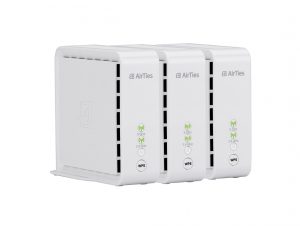
After more than 40 years of operation, DTVE is closing its doors and our website will no longer be updated daily. Thank you for all of your support.
Home truths
Whole-home connectivity presents both a challenge and an opportunity to service providers. It is a clear pain point for the customer but it is technically difficult to solve and risks creating a huge support challenge. Adrian Pennington reports.
 Broadband networks have improved dramatically to the point where service providers can almost guarantee a certain level of connectivity to the home. Most providers’ networks have enough core capacity to ensure that customers aren’t competing for bandwidth in the way that we used to experience during peak hours, in the earlier days of the internet. The last mile is usually pretty reliable too, barring a digger cutting through a customer’s fibre line.
Broadband networks have improved dramatically to the point where service providers can almost guarantee a certain level of connectivity to the home. Most providers’ networks have enough core capacity to ensure that customers aren’t competing for bandwidth in the way that we used to experience during peak hours, in the earlier days of the internet. The last mile is usually pretty reliable too, barring a digger cutting through a customer’s fibre line.
In the fixed-line environment comprising the core network and the last mile network, the broadband service provider is in control and can expand capacity as required.
Inside the home, though, there’s a different story. WiFi has evolved from an amenity to an expected utility. It has become an enabling platform for a growing number of smart home products and systems. WiFi connectivity is an important part of life at home – but in most cases it is not fit for purpose and it is the service provider that gets the blame.
“To say that it is important to invest in WiFi would be a huge understatement,” says Charles Cheevers, CTO, customer premises equipment at Arris. “WiFi is the primary home connection. It is how children get to do their homework and how adults pay the bills or find a way to fix that broken water pipe. It is a consumer’s front door bell, their security system or smart light-switches that they rely on to work smoothly when they’re on holiday. If service providers do not ensure that reliability is embedded within a WiFi system, customers will desert them faster than they can say ‘WiFi’.”
Service providers realise that the bottleneck has shifted into the home. The topic, according to Cheevers, is currently at the top of their agenda.
Service providers are trying to tackle two fundamental problems with connectivity, as outlined by strategic consultants Cartesian.
First, WiFi operates over the radio spectrum, which is a finite resource – service providers can’t simply add more spectrum, as they can in the fixed line world.
Second, service providers can’t control the radio spectrum. “Imagine if a service provider sold you services over the copper line to your home but at any point several other customers could start using the copper line at the same time, with no warning,” says Graham Harvey, head of WiFi services. “There would be chaos.”
The reason for the bottlenecks are explained further by Nokia’s digital home marketer, Laszlo Gyalog: “First, performance can be hampered by interference. Most people are familiar with interference from other WiFi sources but not a lot of people are aware of non-WiFi interference sources, like microwave ovens, Bluetooth devices and the like. Understanding interference sources is a must in order to mitigate the problem, for example, through channel hopping and/or band steering,” he says. “Second, coverage: you may have decent WiFi in the living room – or wherever the router is placed – but less so in other rooms. Third, complexity: today, you have to be somewhat of an engineer to install a WiFi network; arranging SSIDs, choosing the correct WiFi channel, and so on.”
In-home bottlenecks
There are other causes of WiFi bottleneck issues. Consumption of 4K video, online gaming, cloud services, regular software update downloads and other higher bandwidth services is on the up and on more devices – connected TVs, consoles, PCs, tablets, smartphones. These services expect to be delivered by WiFi right across the home – a requirement that cannot always be met by a standalone router, particularly in larger homes.
The average home now has more than seven WiFi connected devices, and the average daily connection time per WiFi device is 10 hours, according to an analysis by technology outfit AirTies. “This makes WiFi one of the most used services in the home, alongside utilities such as water and electricity,” the company states.
“4K video streaming or the addition of outdoor security cameras adds to bandwidth intensive applications which service providers need to address – both inside and outside the home,” adds Arris’ Cheevers.
In small homes and apartments, a conventional standalone router may be sufficient to provide whole-home WiFi connectivity. In larger homes the router will need help in providing whole home coverage, particularly if there are many rooms in the house and multiple floors.
The challenges encountered in achieving whole home WiFi coverage include range. WiFi coverage needs to be provided throughout each floor of the home and perhaps to multiple floors – even to the garden. WiFi signals from conventional routers attenuate significantly each time they propagate through a wall, a floor, furniture etc. making it difficult to cover the outer reaches (e.g. the back bedroom) of the house effectively.
A second challenge is construction. The construction of some homes may preclude the propagation of WiFi from room to room and floor to floor. Stone and concrete floors, foil-backed plasterboard walls and underfloor heating systems are all major obstacles to WiFi generally.
Speed is also a challenge. How can high-speed – perhaps 1Gbps – wireless speeds be provided all around the home? Using conventional routers such WiFi speeds are only possible in the same room as the router or perhaps adjacent rooms.
“Service providers are bringing faster internet speeds to the home, but far too many consumers can’t actually experience that performance because of outdated WiFi gear,” says AirTies chief marketing officer Oz Yildirim.
Conventional WiFi relies on a single access point (AP) from a router/gateway to serve the entire home, but that approach is no longer sustainable to support today’s super-connected homes and streaming video consumption habits. When it becomes apparent that a single AP won’t handle the load, the logical answer is to add more APs, but many houses lack the wired infrastructure to install additional APs.
Two technological approaches predominate today to add and connect APs. One approach is a ‘tree’ topology where WiFi is extended from the core gateway using repeaters/extenders that can only make a single hop, to a gateway or another extender, thus requiring multiple hops for data flow between extenders. Another is to use ‘Mesh’ topology in which every extender connects with each other simultaneously to manage data-flow dynamically.
Some providers are now reselling whole home WiFi retail systems (e.g those of Netgear Orbi, Linksys Velop). “It is of course easier and cheaper for the service provider to support their own whole-home WiFi solution than someone else’s,” says Yildirim.
The effectiveness of the multi-node WiFi solution’s algorithms to handle client roaming (between nodes) is also a key consideration. Such a solution cannot be considered successful if it provides extremely high throughput to a client device but fails to quickly and effectively pass that client device between its nodes when the client roams.
“Another potential performance bottleneck in multi-node WiFi solutions is the inter-node communication paths,” says Harvey. “Hardwiring the individual nodes – via Ethernet – may not be practical but having a dedicated backhaul 5GHz connection between nodes will significantly improve system performance.”
While a single, centrally located AP is the most efficient way to get WiFi throughout the home, it is not always easy to locate the AP centrally. “This means that the requirement for another WiFi extender in the home is not removed. In order to support 4K video services reliably, almost 40% of homes will need at least a single additional WiFi extender,” says Arris’ Cheevers.
Mitigating churn
Increasingly, service providers are engaging with vendors that offer the possibility to manage WiFi systems, so that, if there is a problem with WiFi, at least they can help their customers.
“We are moving from a level of expectation for video on mobile where consumers are ‘OK’ with some buffering and will tolerate some performance issues to expectations of broadcast-quality reliability,” says Simon Trudelle, senior director, product marketing, Nagra. “For operators the challenge is that if something goes wrong in the home they will get the customer call and a related cost, including possibly sending a technician on site. Operators have to get it right. It’s a big factor in their reputation.”
In fact, a UK/US consumer survey released in 2017 by AirTies found that more than half of all subscribers have called their service providers to complain about their home internet or WiFi performance.
“Most consumers simply don’t distinguish between the internet and WiFi,” says Yildirim. “To them, those two terms mean the same thing, which presents a major challenge, as well as opportunity, for service providers. Consumers are paying for faster and faster speeds, but don’t experience consistent high-quality internet around the house. They run a speed-test app, see the results, and call their service provider to complain.”
The same survey found that 78% of respondents would prefer if their ISPs provided them with their in-home WiFi networking gear, versus purchasing it themselves through retail outlets.
Not surprisingly, according to AirTies – developer of a managed Mesh WiFi system – in homes without WiFi Mesh extenders, only 50% have consistent, high-quality WiFi coverage throughout, and 25% have noticeably poor coverage. “Service providers understand this bottleneck and are turning to WiFi Mesh for the solution,” claims Yildirim.
It is not just outdated WiFi gear but a lack of WiFi software intelligence that is seen as a primary cause of in-home internet bottlenecks.
“One of the most critical issues facing service providers is their lack of visibility and control over their subscribers’ in-home WiFi experience,” says Yildirim. AirTies’ Remote Manager is a cloud-based platform that provides home WiFi performance data, management, and analytics to support field technicians, network engineering, and customer care.
Instead of waiting for something to go wrong, and the customer calling the service provider with a complaint of ‘my broadband isn’t working’, the service provider needs to proactively look for signs of connectivity problems and communicate that to the customer.
 “Maximising whole-home connectivity in the future will depend on changing the relationship between the service provider and customer,” says Cartesian’s Harvey (left).
“Maximising whole-home connectivity in the future will depend on changing the relationship between the service provider and customer,” says Cartesian’s Harvey (left).
“To truly benefit from whole home WiFi the solution needs to be self-healing, self-optimising – always using the best channel/band – and needs to provide a real-time management tool including recommendations to effectively and quickly solve any remaining issues,” agrees Gyalog. “Retail systems lack these management capabilities.”
Gyalog says Nokia’s WiFi portfolio combines capabilities like real-time channel monitoring, real-time spectrum analysis and real time link monitoring with a Mesh topology, “and provides a real-time management tool to provide the helpdesk with a holistic view on the in-home network.”
Other vendors of whole home WiFi systems with management capabilities include Plume and Huawei. It’s a key feature of the WiFi Certified EasyMesh too. The standards initiative from the WiFi Alliance enables home WiFi networks to combine gateways and access points from multiple vendors, including those supplied by a broadband provider and those bought via retail.
Based on the Multi-Access Point (AP) specification and using CableLabs’ research, WiFi Certified EasyMesh is supported by vendors including Broadcom and Arris. The latter’s support of the standard in its HomeAssure whole-home WiFi solution means its gateway and WiFi extender products will be compliant. AirTies and SoC providers Intel and Marvell have also backed the standard.
Liberty Global, which has installed its modem and WiFi gateway Connect Box in more than 10 million homes worldwide, has backed the initiative too.
“Importantly for service providers, all of this means that they are taking on a new type of problem with in-home connectivity,” says Harvey. “They can’t simply throw more hardware at the customer and rely on it working – they need to be able to provide ongoing service and support, to help the customer solve problems in an ever-changing environment.”
Level of speed
The benchmark speed/throughput that service providers want to deliver in subscribers’ homes varies, but the trickier issue they grapple with is consistency.
“Explaining to subscribers why their internet performance varies from room to room, device to device, and even minute by minute, is a real headache for service providers,” says Yildirim who argues that Mesh WiFi enables service providers to deliver consistent, quality internet in every corner of the home.
Depending on the whole home WiFi system (entry-level; high-end), anything from 100Mbps to 300Mbps in every room is possible. Often there is a trade-off between raw speed and stability – operators are trying to find solutions that can give them the best of both worlds.
“There may be occasions when raw throughput is the key selling point. Take an update to a game on a console, which might be 5GB. Gamers have to wait for the software update to complete before they can start playing – at 20Mbps, that’s 30 minutes of waiting; at 100Mbps, only seven minutes; 500Mbps, one minute, and so on. In these cases, raw throughput really makes a difference,” says Harvey. “However, for other use cases, it’s reliability that matters. If a large family has a fibre connection to the home guaranteeing a 100Mbps connection, it should be pretty confident about the ability to stream Ultra HD to the main TV set, another HD stream to a tablet in the kitchen, and a couple more HD streams to devices in upstairs bedrooms. That’s only 40Mbps of total bandwidth and yet WiFi can often fail to deliver in this kind of scenario. Each device is in a different location, with a different connection strength. Interference can affect any one of the connections at any time, and the WiFi network needs to intelligently cope with all of this, trying to maintain a stable connection to all devices at all times.”
Cartesian believes no amount of investment will guarantee whole-home connectivity, at least not using WiFi. “For operators the question is how much support they are willing to provide, and how they charge for it,” says Harvey.
New support requirements will mean changes to service providers’ operating models but also the ability to reduce churn, increase ARPU and reduced OPEX. There’s value alone in reducing customer service calls and enhancing brand reputation.
Liberty Global’s Connect Box monitors the signal across multiple devices for continuous optimisation. According to its chief product officer, Doron Hacmon, the level of customer satisfaction is significantly higher than before.
AirTies quotes from a survey of customers of more than a dozen service providers who have deployed AirTies Managed Mesh WiFi solution. Notably, 75% reported a decrease in churn since using AirTies; 80% agreed there has been an increase in customer satisfaction after deploying the solution; 77% are offering or considering offering WiFi Mesh as a premium subscription service as an incremental revenue stream and 67% report there has been a decrease in WiFi related support calls after deploying AirTies.
“If problems can be solved in the home before they are detected by the end-users, this leads to satisfied customers, hence reducing customer churn,” says Gyalog.
Service providers can increase ARPU by selling whole home connectivity devices, and potentially by offering a managed WiFi service. Waoo! in Denmark charges e6 a month for such a service; for subscribers of their higher tier broadband subscriptions, the service is included.
“If service providers introduce a decent management tool, that gives a holistic view into the in-home network, and are able to solve issues quickly, they can reduce operational expenses. Today a WiFi related call to the helpdesk takes 20-30 minutes to solve,” says Gyalog. “If you combine this with the automatic/autonomous issue solving, this can dramatically reduce the OPEX, by also reducing the amount of calls to the helpdesk.”
In the US, Comcast’s Xfinity xFi gives customers a dashboard from which they can see the status of devices on their WiFi network, turn devices on and off, and control the times at which WiFi can be used by different members of the household.
This type of control interface can be easily extended to the management of any number of smart home devices.
“If customers are happy with their in-home connectivity, they will use their devices more intensively, which eventually will lead to a demand for higher tier broadband subscriptions,” says Gyalog.
“One of the most promising things we see happening today as that service providers are actually using premium WiFi as a differentiator from their competitors, and as a new way to monetize their broadband portfolio,” says Yildirim. “By having a premium WiFi option for subscribers, some operators are using it as an upgrade incentive to higher-tier broadband subscription plans, while others are using it to generate new monthly subscription revenues, and several are using a combination of these approaches.”
Once a whole home connectivity service is in place, this can be extended with smart home services, combining WiFi connectivity with ZigBee/Z-Wave, to control anything from webcams to smart sensors.
“If service providers want to offer even more smart-home services, ultra HD video, or high-bandwidth applications such as VR/AR, the need to have consistent, quality WiFi in every corner of the home is clearly fundamental,” says Yildirim.
“Ultimately, what customers will want to see is some or all of these features as part of a service provider’s WiFi offering,” says Cheevers. “When customers don’t see the value of their investment and experience a problematic service, they’ll start to question that investment.”
In Focus: Evolving WiFi technology
WiFi technology continues to evolve and may provide additional whole home connectivity solutions.
For example, current WiFi technology 802.11ac 4×4 MIMO supports up to Gigabit speeds but not simultaneously to all devices spread within the home.
802.11ac Wave 2 technology offers support for 160MHz channels, MU-MIMO and Beam Forming and these may be able to overcome this limitation by supporting multi-gigabit speeds.
All eyes are on the roll-out of 802.11ax which promises dramatic improvements in quality, speed, and efficiency.
802.11ax or High-Efficiency Wireless promises a fourfold increase in average throughput per user through more efficient use of the 2.4GHz and 5GHz bands and is designed specifically for high-density public environments, like trains, stadiums and airports. But it also will be beneficial in heavy-usage homes, apartment buildings and in offices that use bandwidth-hogging applications like video-conferencing.
The IEEE is not expected to have it finalised before 2019 although pre-standard chipsets have shipped and the first 802.11ax routers will debut later this year, targeted at gamers. Expect to see Mesh Wi-Fi solutions that use 802.11ax hit the market that will deliver the ultimate in-home Wi-Fi experience.



